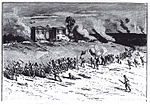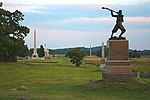Battle of Gettysburg, second day

During the second day of the Battle of Gettysburg (July 2, 1863) Confederate Gen. Robert E. Lee attempted to capitalize on his first day's success. His Army of Northern Virginia launched multiple attacks on the flanks of the Union Army of the Potomac, commanded by Maj. Gen. George G. Meade. The assaults were unsuccessful, and resulted in heavy casualties for both sides. After a short delay to assemble his forces and avoid detection in his approach march, Lt. Gen. James Longstreet attacked with his First Corps against the Union left flank. His division under Maj. Gen. John Bell Hood attacked Little Round Top and Devil's Den. To Hood's left, Maj. Gen. Lafayette McLaws attacked the Wheatfield and the Peach Orchard. Although neither prevailed, the Union III Corps was effectively destroyed as a combat organization as it attempted to defend a salient over too wide a front. Gen. Meade rushed as many as 20,000 reinforcements from elsewhere in his line to resist these fierce assaults. The attacks in this sector concluded with an unsuccessful assault by the Confederate Third Corps division of Maj. Gen. Richard H. Anderson against the Union center on Cemetery Ridge. That evening, Confederate Second Corps commander Lt. Gen. Richard S. Ewell turned demonstrations against the Union right flank into full-scale assaults on Culp's Hill and East Cemetery Hill, but both were repulsed. The Union army had occupied strong defensive positions, and Meade handled his forces well, resulting in heavy losses for both sides, but leaving the disposition of forces on both sides essentially unchanged. Lee's hope of crushing the Army of the Potomac on Northern territory was dashed, but undaunted, he began to plan for the third day of fighting. This article includes details of many attacks on the Union left flank (Devil's Den, the Wheatfield, and the Peach Orchard) and center (Cemetery Ridge), but separate articles describe other major engagements in this massive battle of the second day: Little Round Top Culp's Hill Cemetery Hill
Excerpt from the Wikipedia article Battle of Gettysburg, second day (License: CC BY-SA 3.0, Authors, Images).Battle of Gettysburg, second day
Bus & Handicapped Drop Off Lane,
Geographical coordinates (GPS) Address Nearby Places Show on map
Geographical coordinates (GPS)
| Latitude | Longitude |
|---|---|
| N 39.81124 ° | E -77.22487 ° |
Address
Police Parking
Bus & Handicapped Drop Off Lane
17325
Pennsylvania, United States
Open on Google Maps










